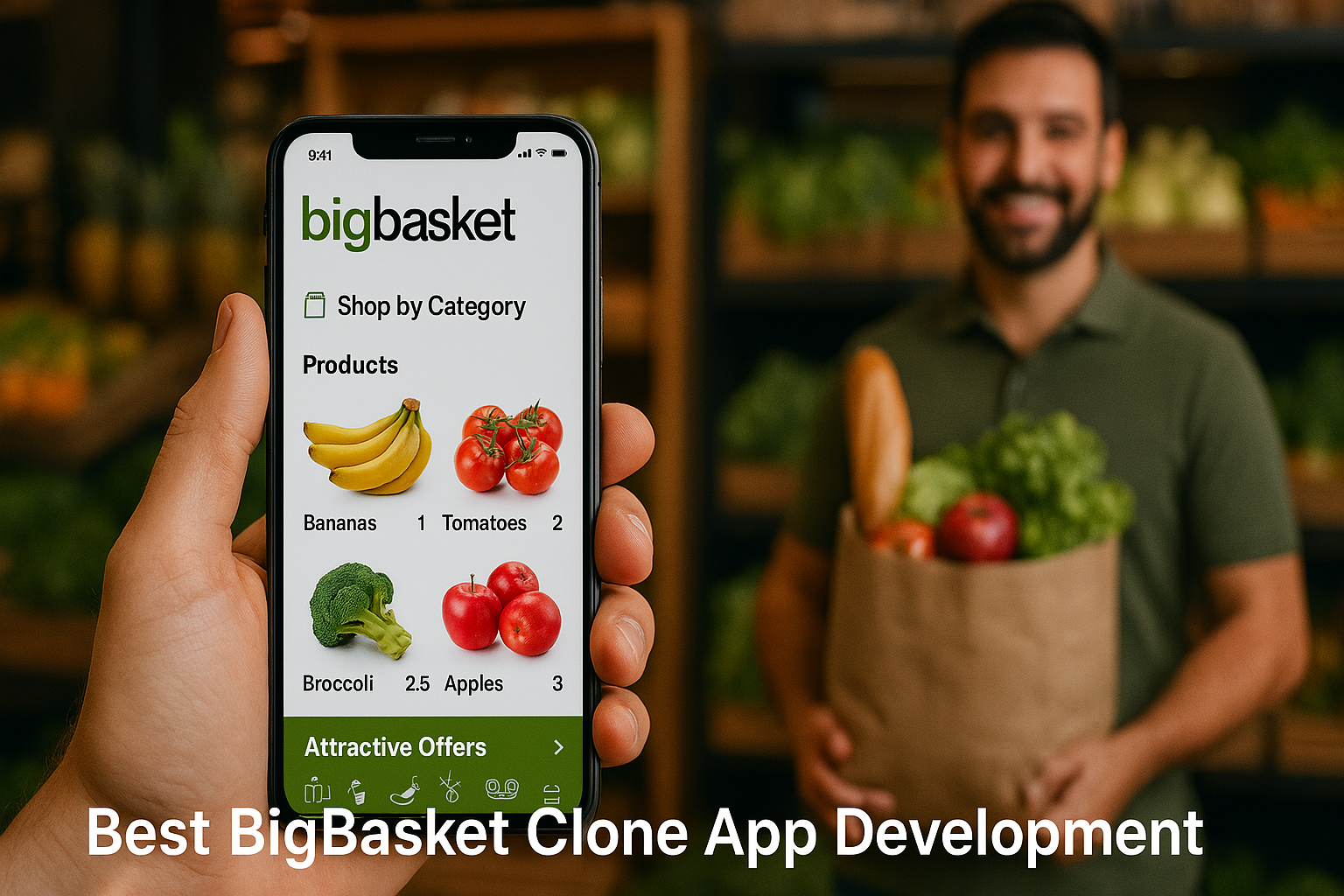Introduction
In today’s fast-paced digital world, the demand for online grocery delivery services has skyrocketed. With the rise of e-commerce, businesses are looking to replicate successful models like BigBasket to create their own grocery delivery apps. A BigBasket clone app is a ready-made solution that allows businesses to launch an on-demand grocery delivery platform efficiently.
This comprehensive guide will cover every aspect of BigBasket clone app development, including features, benefits, development process, technology stack, cost estimation, and monetization strategies.
Why Develop a BigBasket Clone App?
1. Growing Demand for Online Grocery Services
The demand for online grocery shopping has skyrocketed, especially after the COVID-19 pandemic. Consumers prefer convenience, which makes an on-demand grocery app a lucrative business opportunity.
2. High Revenue Potential
Online grocery stores generate revenue through multiple streams, including delivery fees, subscriptions, partnerships, and advertisements.
3. Competitive Edge
Having a well-developed BigBasket clone app helps businesses stay competitive and capture a significant market share.
Key Features of a BigBasket Clone App
1. User Panel Features
- Easy Registration & Login: Allow users to sign up via email, phone number, or social media.
- Smart Search & Categories: Enable users to browse and search products effortlessly.
- Add to Cart & Wishlist: Save items for future purchases.
- Multiple Payment Options: Include UPI, credit/debit cards, net banking, and wallets.
- Order Tracking: Real-time updates on order status.
- Scheduled Delivery: Customers can choose a convenient delivery time.
- Discounts & Coupons: Offer special deals to attract more users.
- Push Notifications: Keep users informed about offers and order updates.
2. Admin Panel Features
- Dashboard Management: Monitor orders, revenue, and user activities.
- Product & Category Management: Add, remove, or update product details.
- Order Management: Track and manage orders efficiently.
- User & Vendor Management: Handle users and sellers effectively.
- Payment & Commission Management: Monitor transactions and commissions.
- Reports & Analytics: Gain insights into sales and customer behavior.
3. Delivery Partner Features
- Login & Profile Management: Secure access for delivery agents.
- Order Notifications: Real-time order assignments.
- Route Optimization: Helps in fast and efficient delivery.
- Earnings & Reports: Track daily earnings and order history.
Step-by-Step Guide to Develop a BigBasket Clone App
1. Market Research & Planning
- Analyze competitors and target audience.
- Identify key features to implement.
- Determine monetization strategies.
2. Choosing the Right Tech Stack
- Frontend: React Native, Flutter (for cross-platform development).
- Backend: Node.js, Django, or Laravel.
- Database: MySQL, PostgreSQL, or MongoDB.
- Cloud Services: AWS, Firebase, or Google Cloud.
3. UI/UX Design
- Create wireframes and prototypes.
- Focus on a user-friendly interface.
- Optimize for mobile responsiveness.
4. Development Process
- Backend Development: Set up the database and server-side logic.
- Frontend Development: Build an interactive UI.
- API Integration: Connect payment gateways, maps, and notifications.
- Testing: Perform unit, integration, and user testing.
5. Deployment & Launch
- Deploy the app on Play Store and App Store.
- Optimize for SEO to improve discoverability.
- Run marketing campaigns to attract users.
Monetization Strategies
Developing a BigBasket clone app can be highly profitable if you implement the right monetization strategies. Below are six proven ways to generate revenue from your online grocery delivery app:
1. Commission-Based Model
Charge a commission from grocery vendors and stores for each order placed through your app. This is one of the most effective ways to earn revenue, as stores benefit from increased sales while you get a percentage of each transaction.
2. Subscription Plans (Membership Model)
Introduce a premium subscription plan where users can enjoy exclusive benefits such as free delivery, discounts, and priority service. A well-known example is BigBasket’s “BB Star” membership, which ensures customer loyalty while providing a steady revenue stream.
3. Delivery Charges
Implement dynamic delivery charges based on factors such as order value, distance, and delivery speed. Offer free delivery for high-value orders to encourage bulk purchases while ensuring profitability on smaller ones through minimal fees.
4. Advertisement & Promotions
Earn by allowing grocery stores and brands to run sponsored listings, banner ads, and featured product placements on your app. This model ensures additional income while increasing visibility for vendors.
5. Surge Pricing (Peak-Time Charges)
Introduce surge pricing during high-demand hours, weekends, or festive seasons. This method helps maximize profits by adjusting delivery fees based on supply and demand fluctuations.
6. White-Label Solutions & Franchise Model
Expand your business by licensing your BigBasket clone app as a white-label solution to entrepreneurs looking to start their grocery delivery business. Alternatively, offer a franchise model where partners operate under your brand in different locations.
SEO Optimization for BigBasket Clone App
1. Keyword Optimization
Use relevant keywords like “online grocery app development,” “BigBasket clone app,” and “grocery delivery app.”
2. High-Quality Content
Create informative blogs, FAQs, and user guides to engage customers.
3. Mobile Optimization
Ensure the app is mobile-friendly for better ranking.
4. Link Building
Gain backlinks from reputed websites and directories.
5. Technical SEO
Optimize site speed, structured data, and metadata for better visibility.
Conclusion
Developing a BigBasket clone app requires strategic planning, technical expertise, and a strong marketing approach. By following this guide, businesses can successfully enter the online grocery delivery market and maximize their revenue potential.



